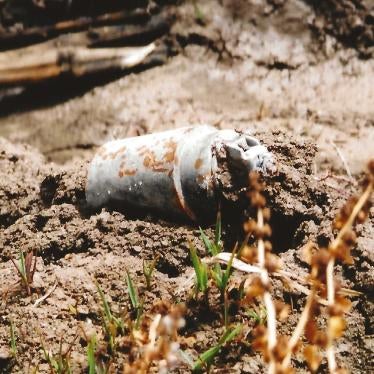Thanks to all the speakers for a really great job.
Prince Mired put it very eloquently. Essentially, there are no good reasons for not joining the Mine Ban Treaty for the United States and there are an awful lot of compelling reasons why it should do so—in terms of benefits to the US, benefits to the treaty, benefits to international security, and benefits to the victims around the world.
A whole series of excuses have been given over the years for why the US can’t join the Mine Ban Treaty.
The one that’s perhaps heard more often than anything else is the Korean peninsula. Back in 1997 at the time of the negotiations and immediately afterward the perceived need to use antipersonnel landmines to stop the threat of a North Korean invasion was cited most frequently. My own view and I think that of many others is that Korea is cited most often because it’s the easiest sell. It frightens people the most, including the public and people on Capitol Hill, by convincing them that landmines are still needed for security purposes.
But in fact there may be no place on Earth where the lowly antipersonnel landmine is needed less than on the Korean peninsula. That’s because there is nowhere on Earth where the potential of an invasion has been thought through so heavily and where there are so many systems and redundant systems, and redundant systems on top of redundant systems that are designed precisely to fulfill missions that antipersonnel mines traditionally in the past have played. For early warning or to slow down an attack or to create fear, all these things can be accomplished in many different ways without having to resort to the use of antipersonnel mines. There are lots of forces, systems and equipment in place that are designed to do that on the Korean peninsula.
It is not an antipersonnel mine that is going to determine the success or failure of any aggression from North Korea. The war plan calls for taking the battle to the north, in any event, not waiting for mines to stop or slow down the enemy. In the 1990s, as a ban on mines was being seriously considered, several of the former commanders of US forces in Korea, the top dogs, stated publicly that antipersonnel mines were not an important part of war plans. They said that mines were not something they ever thought about as being a crucial part of any battle with North Korea. But the argument plays well—me must do anything to stop the crazy communists from invading—so we still continue to hear it from time to time.
It’s been our understanding that during the course of this policy review, which is now dragged on into its fifth year, the idea of Korea being a sticking point because of the need for antipersonnel landmines, has become less and less important, realizing that there are lots of other ways to fight.
While we haven’t talked about it yet here today, there’s a need to emphasize that the US has already banned the use of what most people think of as antipersonnel landmines, the ones that you stick in the ground and walk away from. The US has banned the use of those weapons, the so called dumb mines, since 2011 in Korea and everywhere else in the world. So the US is thinking about using other types of antipersonnel mines, those that are remotely-delivered.
The notion of needing to plant a lot of landmines to slow down troops charging south just isn’t the case anymore. The mines that are already laid in the DMZ are not US landmines and wouldn’t have to be dealt with if the US were to join this treaty because legally the mines belong to South Korea.
But the review has raised the issue of what to do about the joint command structure in South Korea. If war comes to the Korean peninsula, South Korean forces technically would become under the command of the US general. So if the US were to join the Mine Ban Treaty it could create difficulties if South Korea wants to use banned antipersonnel mines as the US general would be prohibited from being able to order the use of those mines.
But the command structure in South Korea has been under review for a long time. A couple years ago it was slated to change over and put the South Koreans in charge of their own forces in wartime. Implementation of that decision has been delayed several times now and probably will remain open for a while longer, but it’s already been agreed by the both US and South Korea. So the command structure shouldn’t be an obstacle for the US banning landmines either. The situation on the Korean peninsula is not a compelling reason for the US not to join the Mine Ban Treaty, but if the review goes the wrong way it will not surprise me if that’s the first thing they cite.
The other reason that is often cited for the US not joining the Mine Ban Treaty is the desire of the military to continue to have the option to use so-called smart mines. “Dumb” mines are the ones that you put in the ground, while the “smart” mines are dropped out of aircraft or fired by artillery or rocket systems, often delivered by the hundreds or thousands. They scatter mines over a very wide area, with tripwires deployed that would detonate when people come along later.
During the treaty negotiations in Oslo in September 1997, the US tried to get an exception for these “smart” mines by arguing that they are not dangerous and that they don’t pose the same kind of dangers as “dumb” mines. It sent a team of generals to the negotiations to try and convince the nations present that “smart” mines were different and did not need to be banned. The US was rebuffed by its closest military allies, who listened to the arguments that these kinds of landmines are also indiscriminate, would have high failure rates, and would pose unacceptable danger to civilians.
We’ve heard that there’s a need for “alternatives” to be developed before the US can join the Mine Ban Treaty. Well, the US has not made any real efforts to try to develop those alternatives, so this has been a sort of hollow rationale that has been put forth. But truth is, the US has found the alternatives. It has fought an awful lot of wars and battles over the course of the last 23 years, and hasn’t had to use antipersonnel mines. That sounds like they found an alternative to me. Other existing weapons, other tactics, other ways of carrying out the missions have been found, and have been found in all kinds of different settings, including high intensity conflict and low intensity conflict in many different regions and areas.
The true reason why the US hasn’t joined the Mine Ban Treaty goes back to the fact they it wasn’t part of the leadership on this at the time of negotiations and doesn’t like to come in after the fact. The US doesn’t like this notion of the slippery slope, the argument that Senator Leahy referred to, which is the fear that if you give up antipersonnel mines than you’ll have to give up something else. This is something that they probably should be worried about.
We were very focused on landmines at the time of negotiations but indeed now we do look at other weapons systems that have the same kind of negative humanitarian impact. But you shouldn’t refuse to give up one system that crosses the line in terms of dangers to civilians, because you are concerned that later you might have to give up another weapon that crosses the line. So, in the end that is really a counter-productive argument as well.
In my view the US will never use antipersonnel landmines again. It will be politically impossible for the US to do so. The Mine Ban Treaty includes nearly all of the US’s military allies including every other NATO member, major allies such as Australia and Japan, and countries where the US has been fighting wars such as Afghanistan and Iraq. So it will be politically impossible for the US to use these weapons again.
The lack of US accession to the Mine Ban Treaty shows a weakness of political leadership. It almost defies belief that the US hasn’t been able to come on board the treaty after all these years and after all of the positive developments that have happened as a result of the treaty. So it is time for the US to jump on board.
This is a humanitarian imperative. It’s not a military decision, but a moral one, as Prince Mired said. And the time to do that is now. This review is about to wrap up, possibly any day, any week now it seems. It may be the last chance, before it falls to another generation of humanitarians to make sure the right thing is done.
Thank you.
Steve Goose is executive director of the Arms Division of Human Rights Watch and chair of the International Campaign to Ban Landmines and Cluster Munition Coalition (ICBL-CMC). Steve played a central role in the creation of the Mine Ban Treaty and is the intellectual architect behind the ICBL’s unprecedented civil society-based verification initiative, Landmine and Cluster Munition Monitor. Steve has been at the forefront of international efforts to address the humanitarian harm caused by other weapons, including the global bans on cluster munitions and blinding lasers. Before joining Human Rights Watch in 1993, Steve was a staff member of the House Appropriations Committee and a senior researcher at the Center for Defense Information.







